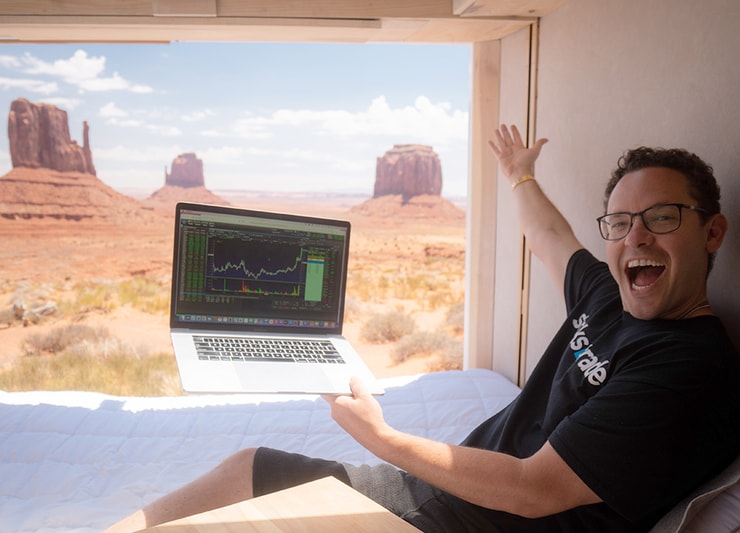Maybe this is the first time you’ve seen a stock like MicroCloud Hologram Inc. (NASDAQ: HOLO) …
But I’ve followed runners like this for YEARS.
It spiked so fast and so high that the chart proportions are trash when I zoom out.
So I’ve got a few charts for you. Here’s a good progression of HOLO on February 7:



$1.51 to $51.
From premarket, to intraday, to afterhours … It spiked 3,200%.
Let me put that in perspective.
$1,000 of HOLO on February 6 would reach a max value of $32,000 less than 48 hours later.
That’s the best case scenario. We’re never going to time it perfectly. But when there’s 3,200% on the table, it’s a lot easier to take the meat of the move.
That’s how I teach my students to trade. And when HOLO started to launch, our chatroom went wild!
I wasn’t the only one to profit. Not by a long shot.

HOLO spiked for a very specific reason.
It’s different from the regular bullish runners with news …
We’ve seen explosive setups like this for years. And if this is your first time, buckle up. These are the market’s most powerful runners.
You won’t find these setups on CNBC, MarketWatch, YahooFinance, etc.
This is niche information.
The setup offers MASSIVE profit opportunities to those who UNDERSTAND the price action.
HOLO isn’t the first mega spiker.
And it’s far from the last …
Table of Contents
How It Started

2025 Millionaire Media, LLCWe usually look for small-cap stocks that announce bullish news.
Those are the best spikers.
- The low share price allows for larger percent gains.
- The low share count indicates a low supply, which helps prices spike higher when demand increases.
- And we need bullish news for a solid catalyst.
- We don’t buy shares if there’s no reason for the stock to spike.
HOLO satisfies the first two factors …
The price was trading below $5 and the float showed less than 1 million shares. Anything below 10 million shares is a low supply.
But the news …
At 5:20 A.M. Eastern, during premarket on February 7, MicroCloud announced plans to join the Communications Industry Association.
Here’s what that means: Absolutely nothing lolol!
Nobody cares about the Communications Industry Association.
That’s like if your grandpa joined the lawn bowling club at his senior-living center. It’s the wimpiest news I’ve seen in weeks.
And yet, share prices launched 3,200%.
Here’s what happened:
This is a crappy stock. It doesn’t deserve to spike 3,200%. And everybody knows that. Especially … The short sellers.
For degenerate traders, a common strategy in the market right now is to short the crappiest stocks that spike in the market.
Theoretically, the strategy makes sense!
These crappy stocks will crash eventually. The movement is unsustainable.
But when short sellers exit their position they have to buy shares. That ADDS bullish momentum to the crappy spike.
And if there are too many short sellers trying to profit, the bullish momentum can turn into a MASSIVE domino effect of short sellers blowing up.
It’s called a short squeeze. And it’s the most powerful catalyst in the market right now.
Short Squeeze Proof

2025 Millionaire Media, LLCThere’s always a layer of secrecy in the market.
We don’t have a public real-time account of everyone’s position.
Here’s my point: There are short sellers that blew up yesterday. But very few of them will share that information publicly.
Luckily, I took some screenshots early on February 7 that show short seller activity as proof.
At 10:04 A.M., still early in the morning, this short seller admitted to a $5k loss.

Even earlier, at 9:19 A.M. there was a short seller eyeing the $5 level.

Remember that HOLO ran to $51. A short position at $5 … that’s a 900% loss.
Short positions CAN lose more money than they’re originally worth. That’s what makes the strategy so dangerous.
I saw HOLO spiking in premarket with crap news. And thanks to my experience in the market, I knew it was a short squeeze.
I even alerted my students in the chat. They had ALL DAY to build a position on this insane runner.
In the video below I explained the opportunity on HOLO during premarket. When the price was still $2.
Again, I wasn’t the only trader to profit.
More Breaking News
- QuantumScape Stock Soars After Breakthrough in Battery Technology Integration
- WBD Stock Soars: Should You Buy Now?
- Civitas Stock Surge: What’s Next?
But seeing as I’m the mentor, let’s go through my trade and the strategy.
Breakout Pattern
Mornings are some of the hottest times to trade in this market. That’s why I’m up early watching the hottest setups.
Profits don’t happen on YOUR schedule, you’ve got to follow the market when these stocks are the hottest.
My real-time trade notes are below:

And there’s a chart below with my position overlaid:

That ‘tiny’ dip during premarket gave me 11%.
A fraction of the 3,200% available that day. But when 90% of traders lose, and short sellers are blowing up their accounts all day … I feel pretty good about an 11% profit.
Also, you’ll come to understand, I’m a better teacher than a trader. Sure, I have $7.5 million in trading profits. But some of my students (Jack Kellogg) already have more trading profits in fewer years.
I sold this stock too early.
But my students got a formal alert at 8:27 A.M. Eastern:
And I have to repeat myself: Traders had ALL DAY to build a position.
Afternoon Spike
There was another blatant profit opportunity in the afternoon.
I didn’t catch it because I was asleep. I’m traveling in Asia and had to shut my laptop before the market closed.
You know, jet lag.
But this is the alert my students received at 3:18 P.M. Eastern before the market closed:
Source: XGPT
An entry price at $11.10.
And the stock ran to $51 during afterhours.
Even if you held until the next day, February 8, when the market opened prices were still trading around $40.
There’s no excuse to sit on your butt right now.
The 2024 market is on fire. And HOLO is not the last short squeeze of the year. Take advantage of this momentum while it lasts!
Here’s the key: New traders learn fastest if they can see these plays happen in real time.
That’s why I hold livestreams. I can cut through market latency and show traders this process as if they were trading it themselves.
Hindsight is 20/20

2025 Millionaire Media, LLCAfter the HOLO spike it’s easy to think: “I just have to buy at $2 and sell at $51”.
But when you’re in the thick of it, it’s not so transparent.
Live video lessons are your key to understanding this profit process.
I’ve been trading with the same patterns for over 2 decades.
They’re the same patterns that my now +30 millionaire students use to trade.
And judging by the chatroom after HOLO spiked … There are a lot more students on their way to the $1 million milestone.
This isn’t rocket science.
I show traders how to recognize the best plays.
Then we get in and out before the crap stock crashes.
Join us for the next LIVE profit opportunity.
I’ll see you in the chat.
Cheers.









Leave a reply